En
The Guide to Digital Photography
with the
DIGITAL CAMERA
E
n
Printed in Japan
S2H05000301(11)
6MAA2011-03
�
Using Your Camera — A Flowchart Guide
STEP 1—Ready the camera
Getting ready
Camera setup
STEP 2—Take pictures
First Steps
Using the SET-UP Menu
Snapshots (auto mode)
Custom shots and movies
Basic Picture Taking
Taking Pictures: The Details
STEP 3—Play them back…
…while shooting…
…after shooting…
Reviewing Your Pictures
Playing Back Your Pictures
…and delete unwanted pictures…
…immediately
…while shooting
…during playback
Delete multiple pictures
Keep or Delete: Picture Review
Reviewing Your Pictures
Playing Back Your Pictures
Using the PLAY BACK Menu
13
120
22
47
31
83
67
31
83
145
STEP 4—Install camera software
Install software
Get to know Nikon View 5
STEP 5—Enjoy your pictures
Quick Start Guide (provided)
Nikon View 5 Reference
Manual (provided on CD)
—
—
Transfer pictures
View pictures on a television
screen
Connecting to a Computer
View pictures on a
TV / VCR
38
46
�
Product Documentation
The documentation for this product
includes the manuals listed below.
Please be sure to read all instructions
thoroughly to get the most from your
camera.
Quick-Start Guide
The Quick-Start Guide takes you
through the process of unpacking
and setting up your Nikon digital
camera, taking your first photo-
graphs, and transferring them to
your computer.
Guide to Digital Photography
The Guide to Digital Photography
(this manual) provides complete
operating instructions for your
camera.
Nikon View 5 Reference Manual
The Nikon View 5 Reference
Manual can be found in electronic
format on the reference CD pro-
vided with your camera. For infor-
mation on viewing the Reference
Manual, see “Connections” in this
manual.
Overview and Symbols
Getting to Know the COOLPIX5700
First Steps
Basic Picture Taking
Reviewing Your Pictures
Connecting to a Computer
Viewing Pictures on a TV / VCR
Using the Camera Controls (All User Sets)
Choosing a User Set
Using the Camera Controls (User Sets 1, 2, 3)
Playing Back Your Pictures
List of Menu Options
Using the Menus
Using the SHOOTING Menu
Using the SET-UP Menu
Using the PLAY BACK Menu
Technical Notes
Index
i
�
For Your Safety
To prevent damage to your Nikon product or injury to yourself or to others,
read the following safety precautions in their entirety before using this equip-
ment. Keep these safety instructions where all those who use the product will
read them.
The consequences that could result from failure to observe the precautions listed
in this section are indicated by the following symbol:
This icon marks warnings, information that should be read before
using your Nikon product to prevent possible injury.
WARNINGS
Do not look at the sun through the
viewfinder
Viewing the sun or other strong light
source through the viewfinder could
cause permanent visual impairment.
Do not leave the viewfinder ex-
posed to direct sunlight
If left in direct sunlight, the lens of the
viewfinder could concentrate sunlight
on the viewfinder’s LCD and cause
damage.
Turn off immediately in the event
of malfunction
Should you notice smoke or an un-
usual smell coming from the equip-
ment or from the AC adapter (avail-
able separately), unplug the AC
adapter and remove the battery im-
mediately, taking care to avoid burns.
Continued operation could result in
injury. After removing the battery,
take the equipment to a Nikon-autho-
rized service center for inspection.
Do not use in the presence of flam-
mable gas
Do not use electronic equipment in
the presence of flammable gas, as this
could result in explosion or fire.
ii
Do not place strap around neck
Placing the camera strap around your
neck could result in strangulation.
Special care should be taken to avoid
placing the strap around the neck of
an infant or child.
Do not disassemble
Touching the product’s internal parts
could result in injury. In the event of
a malfunction, the product should be
repaired only by a qualified technician.
Should the product break open as the
result of a fall or other accident, re-
move the battery and/or AC adapter
and then take the product to a Nikon-
authorized service center for inspec-
tion.
Observe proper precautions when
handling batteries
Batteries may leak or explode if im-
properly handled. Observe the follow-
ing precautions when handling batter-
ies for use in this product:
• Be sure the product is off before re-
placing the battery. If you are using an
AC adapter, be sure it is unplugged.
• Use only a rechargeable Nikon EN-EL1
lithium-ion battery (supplied) or a six-
volt 2CR5 (DL245) lithium battery
(available separately).
�
• When inserting the battery, do not at-
tempt to insert it upside down or
backwards.
• Do not short or disassemble the bat-
• Do not expose the battery to flame or
to excessive heat.
tery.
ter.
• Do not immerse in or expose to wa-
• Do not transport or store with metal
objects such as necklaces or hairpins.
• Batteries are prone to leakage when
fully discharged. To avoid damage to
the product, be sure to remove the
battery when no charge remains.
• When the battery is not in use, attach
the terminal cover and store in a cool
place.
• Immediately after use, or when the
product is used on battery power for
an extended period, the battery may
be hot. Before removing the battery,
turn the camera off and allow the
battery to cool.
• Discontinue use immediately should
you notice any changes in the battery,
such as discoloration or deformation.
Use appropriate cables
When connecting cables to the input
and output jacks, use only the cables
provided or sold by Nikon for the pur-
pose, to maintain compliance with
product regulations.
Keep out of reach of children
Particular care should be taken to pre-
vent infants from putting the battery
or other small parts into their mouths.
Removing memory cards
Memory cards may become hot dur-
ing use. Observe due caution when
removing memory cards from the
camera.
CD-ROMs
The CD-ROMs on which the software
and manuals are distributed should
not be played back on audio CD
equipment. Playing CD-ROMs on an
audio CD player could cause hearing
loss or damage the equipment.
Observe caution when operating
the flash
Using the flash close to your subject’s
eyes could cause temporary visual im-
pairment. Particular care should be
observed if photographing infants,
when the flash should be no less than
one meter (39˝) from the subject.
When using the viewfinder
When operating the diopter adjust-
ment dial with your eye to the
viewfinder, care should be taken not
to put your finger in your eye acciden-
tally.
Avoid contact with liquid crystal
Should the monitor or viewfinder
break, care should be taken to avoid
injury due to broken glass and to pre-
vent liquid crystal from the monitor
touching the skin or entering the eyes
or mouth.
iii
�
Notices
• No part of the manuals included with this product may be reproduced, trans-
mitted, transcribed, stored in a retrieval system, or translated into any lan-
guage in any form, by any means, without Nikon’s prior written permission.
• Nikon reserves the right to change the specifications of the hardware and
software described in these manuals at any time and without prior notice.
• Nikon will not be held liable for any damages resulting from the use of this
product.
• While every effort has been made to ensure that the information in these
manuals is accurate and complete, we would appreciate it were you to bring
any errors or omissions to the attention of the Nikon representative in your
area (address provided separately).
Notice for customers in Canada
CAUTION
This class B digital apparatus meets all requirements of the Canadian Interfer-
ence Causing Equipment Regulations.
ATTENTION
Cet appareil numérique de la classe B respecte toutes les exigences du Règle-
ment sur le matériel brouilleur du Canada.
A Note on Electronically-Controlled Cameras
In extremely rare instances, unusual characters may appear in the control panel
and the camera may stop functioning. In most cases, this phenomenon is
caused by a strong external static charge. Turn the camera off, remove and
replace the battery, and turn the camera on again, or, if you are using an AC
adapter (available separately), disconnect and reconnect the adapter and turn
the camera on again. In the event of continued malfunction, contact your
retailer or Nikon representative. Note that disconnecting the power source as
described above may result in loss of any data not recorded to the memory card
at the time the problem occurred. Data already recorded to the memory card
will not be affected.
iv
�
Notice for customers in the U.S.A.
Federal Communications Commission (FCC) Radio Frequency Interfer-
ence Statement
This equipment has been tested and
found to comply with the limits for a
Class B digital device, pursuant to Part
15 of the FCC rules. These limits are
designed to provide reasonable pro-
tection against harmful interference in a residential installation. This equip-
ment generates, uses, and can radiate radio frequency energy and, if not in-
stalled and used in accordance with the instructions, may cause harmful inter-
ference to radio communications. However, there is no guarantee that inter-
ference will not occur in a particular installation. If this equipment does cause
harmful interference to radio or television reception, which can be determined
by turning the equipment off and on, the user is encouraged to try to correct
the interference by one or more of the following measures:
• Reorient or relocate the receiving antenna.
• Increase the separation between the equipment and receiver.
• Connect the equipment into an outlet on a circuit different from that to
which the receiver is connected.
• Consult the dealer or an experienced radio/television technician for help.
CAUTIONS
Modifications
The FCC requires the user to be notified that any changes or modifications made
to this device that are not expressly approved by Nikon Corporation may void
the user's authority to operate the equipment.
Interface Cables
Use the interface cables sold or provided by Nikon for your equipment. Using
other interface cables may exceed the limits of Class B Part 15 of the FCC rules.
Nikon Inc.,
1300 Walt Whitman Road, Melville, New York
11747-3064, U.S.A.
Tel.: 631-547-4200
v
�
Notice Concerning Prohibition of Copying or Reproduction
Note that simply being in possession of material that has been digitally copied or repro-
duced by means of a scanner, digital camera or other device may be punishable by law.
• Items prohibited by law from being
• Cautions on certain copies and repro-
copied or reproduced
Do not copy or reproduce paper money,
coins, securities, government bonds, or
local government bonds, even if such cop-
ies or reproductions are stamped
“Sample.”
The copying or reproduction of paper
money, coins, or securities which are cir-
culated in a foreign country is prohibited.
Unless the prior permission of the govern-
ment has been obtained, the copying or
reproduction of unused postage stamps
or post cards issued by the government is
prohibited.
The copying or reproduction of stamps
issued by the government and of certified
documents stipulated by law is prohibited.
ductions
The government has issued cautions on
copies or reproductions of securities is-
sued by private companies (shares, bills,
checks, gift certificates, etc.), commuter
passes, or coupon tickets, except when a
minimum of necessary copies are to be
provided for business use by a company.
Also, do not copy or reproduce passports
issued by the government, licenses issued
by public agencies and private groups, ID
cards, and tickets, such as passes and meal
coupons.
• Comply with copyright notices
The copying or reproduction of copy-
righted creative works such as books, mu-
sic, paintings, woodcut prints, maps,
drawings, movies, and photographs is
prohibited except when it is done for per-
sonal use at home or for similar restricted
and non-commercial use.
Trademark Information
Apple, the Apple logo, Macintosh, Mac OS, PowerBook, and QuickTime are registered trademarks of
Apple Computer, Inc. Finder, iMac, and iBook are trademarks of Apple Computer, Inc. IBM and Microdrive
are registered trademarks of International Business Machines Corporation. Microsoft and Windows are
registered trademarks of Microsoft Corporation. Pentium is a trademark of Intel Corporation. Internet
is a trademark of Digital Equipment Corporation. CompactFlash is a trademark of SanDisk Corpora-
tion. Lexar Media is a trademark of Lexar Media Corporation. Adobe and Acrobat are registered trade-
marks of Adobe Systems Inc. Zip is a registered trademark of Iomega Corporation in the U.S. and other
countries. All other trade names mentioned in this manual or the other documentation provided with
your Nikon product are trademarks or registered trademarks of their respective holders.
vi
�
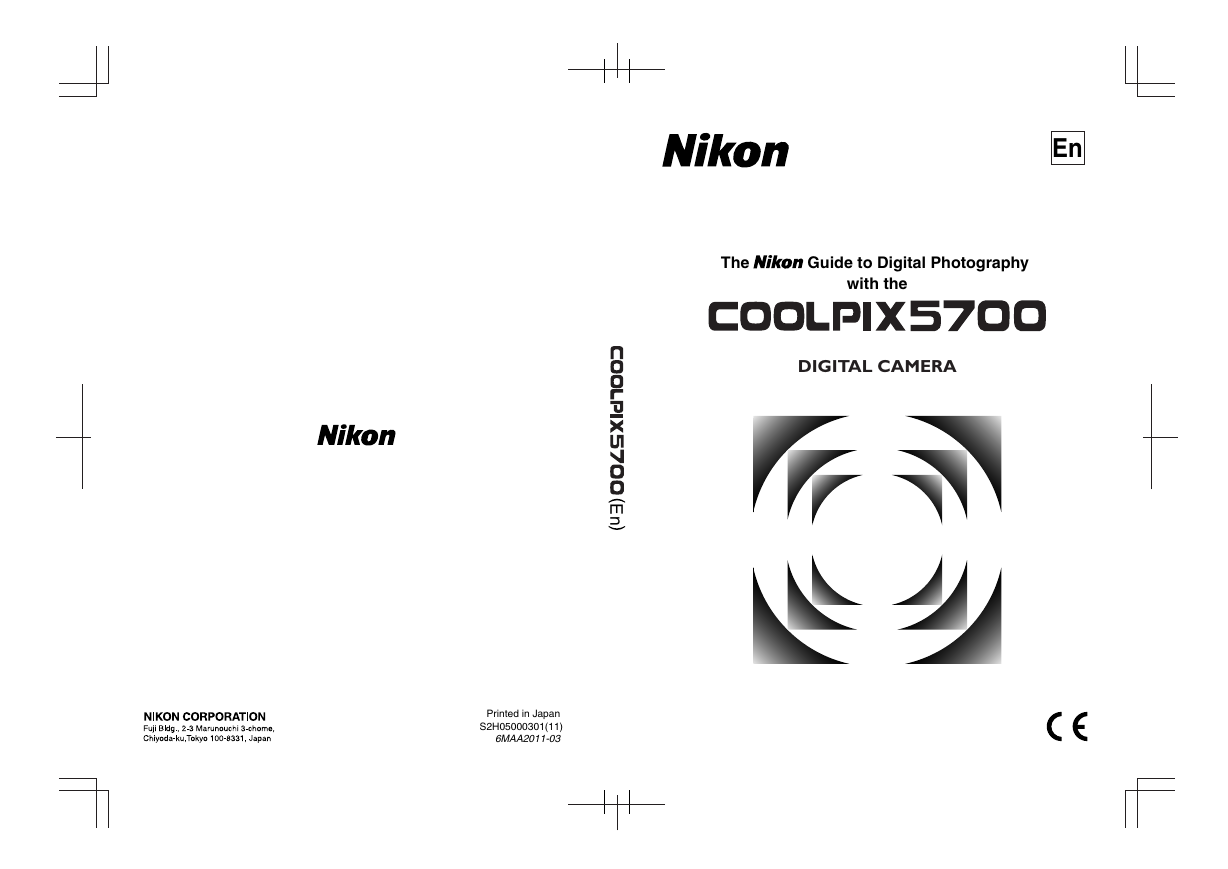

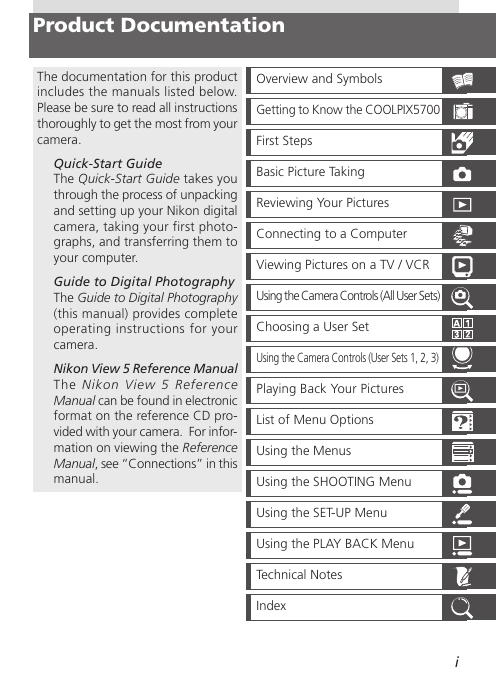
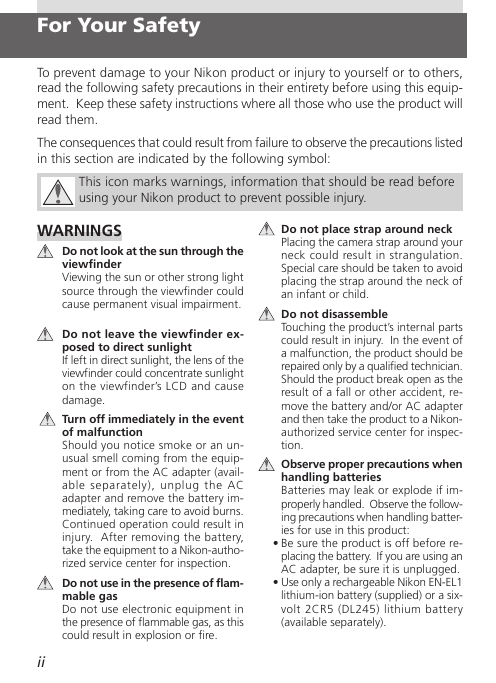
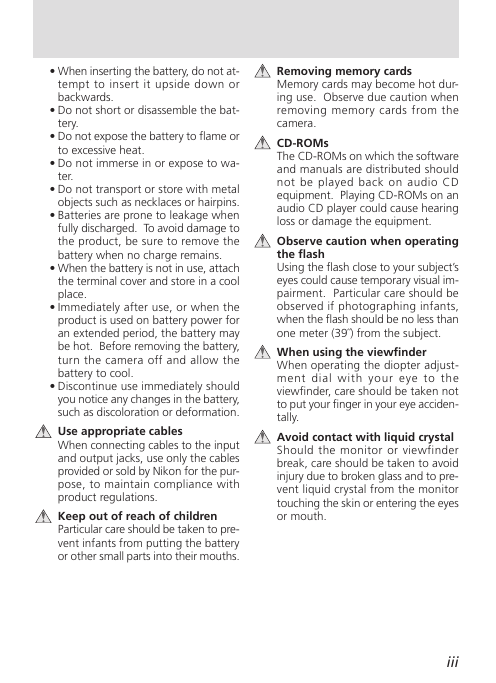
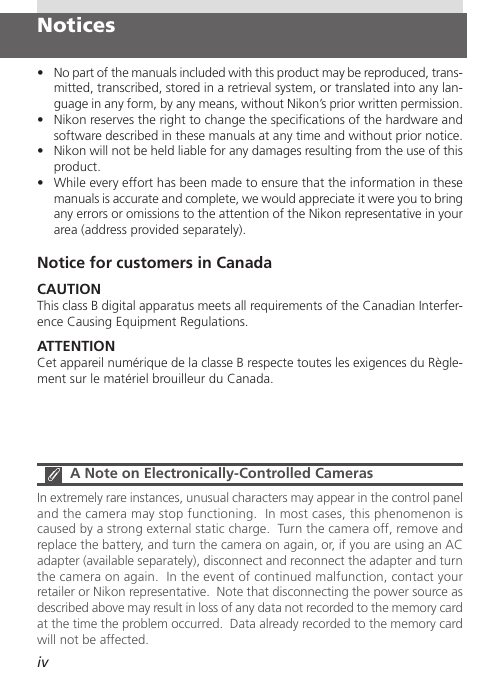
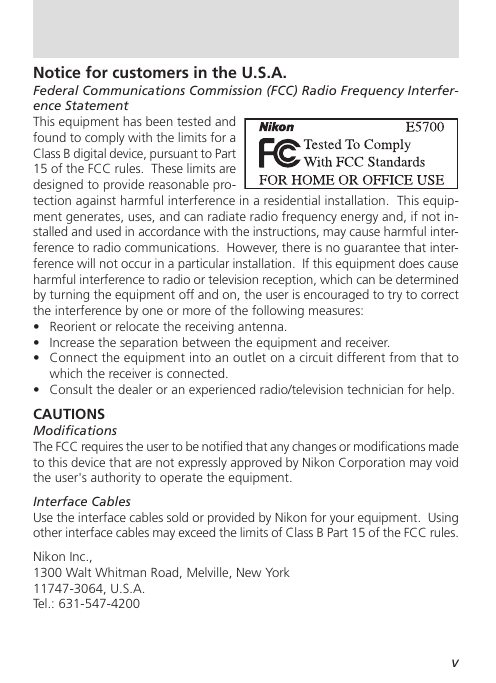
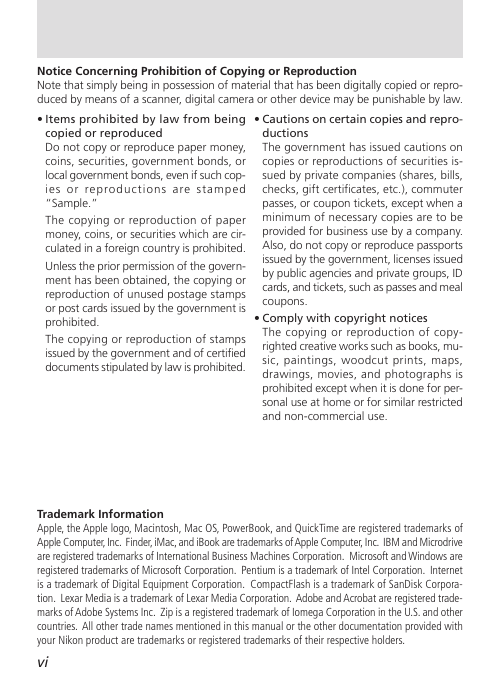








 2023年江西萍乡中考道德与法治真题及答案.doc
2023年江西萍乡中考道德与法治真题及答案.doc 2012年重庆南川中考生物真题及答案.doc
2012年重庆南川中考生物真题及答案.doc 2013年江西师范大学地理学综合及文艺理论基础考研真题.doc
2013年江西师范大学地理学综合及文艺理论基础考研真题.doc 2020年四川甘孜小升初语文真题及答案I卷.doc
2020年四川甘孜小升初语文真题及答案I卷.doc 2020年注册岩土工程师专业基础考试真题及答案.doc
2020年注册岩土工程师专业基础考试真题及答案.doc 2023-2024学年福建省厦门市九年级上学期数学月考试题及答案.doc
2023-2024学年福建省厦门市九年级上学期数学月考试题及答案.doc 2021-2022学年辽宁省沈阳市大东区九年级上学期语文期末试题及答案.doc
2021-2022学年辽宁省沈阳市大东区九年级上学期语文期末试题及答案.doc 2022-2023学年北京东城区初三第一学期物理期末试卷及答案.doc
2022-2023学年北京东城区初三第一学期物理期末试卷及答案.doc 2018上半年江西教师资格初中地理学科知识与教学能力真题及答案.doc
2018上半年江西教师资格初中地理学科知识与教学能力真题及答案.doc 2012年河北国家公务员申论考试真题及答案-省级.doc
2012年河北国家公务员申论考试真题及答案-省级.doc 2020-2021学年江苏省扬州市江都区邵樊片九年级上学期数学第一次质量检测试题及答案.doc
2020-2021学年江苏省扬州市江都区邵樊片九年级上学期数学第一次质量检测试题及答案.doc 2022下半年黑龙江教师资格证中学综合素质真题及答案.doc
2022下半年黑龙江教师资格证中学综合素质真题及答案.doc